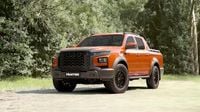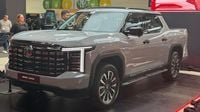In a significant announcement at the Melbourne Motor Show, MG Motor revealed its plans to launch the MG U9, a new pickup truck set to hit Australian roads later this year. The U9, which will also be known as the P9 in China, underscores Australia’s growing importance to the MG brand, which is part of the SAIC Motor Group. This unveiling comes at a time when the Australian pickup market is highly competitive, with numerous established and emerging players vying for consumer attention.
The MG U9 will be exclusively available in a dual-cab body style, a popular choice among Australian consumers. It features a robust ladder frame chassis, similar to many other utes in the market. The decision to offer only a dual-cab variant aligns with MG’s strategy to cater to the Australian market’s preferences, which often favor versatility and practicality.
Under the hood, the U9 will be powered by a new 2.5-litre four-cylinder turbo-diesel engine, delivering a solid 164kW of power. This performance is slightly more than that of the Kia Tasman’s 2.2L engine, which produces 154kW. The engine will be paired with an eight-speed automatic transmission, promising a smooth driving experience. Additionally, the U9 boasts impressive specifications with a towing capacity of 3.5 tonnes and a one-tonne payload, making it a formidable contender against rivals like the Toyota HiLux, Ford Ranger, and Isuzu D-Max.
MG has indicated that hybrid versions of the U9 may be in the pipeline, although details remain sparse. This potential hybridization reflects a broader industry trend towards electrification, as manufacturers respond to increasing consumer demand for more sustainable vehicle options.
Giles Belcher, Chief Commercial Officer of MG Motor Australia, emphasized the importance of local feedback during the U9’s development. “At the end of the day, platform sharing these days is not uncommon,” he stated, referring to the U9’s shared platform with the LDV Terron 9. However, he assured consumers that the U9 has been distinctly tailored for the Australian market, incorporating unique features and enhancements. “This car has been… MG-ified if you like,” he added, highlighting the brand’s commitment to delivering a product that resonates with local preferences.
One of the standout features of the U9 is its innovative rear tailgate, which includes an additional step for easier access to the tub. A unique design allows access from the cabin to the tub, enhancing functionality for users who require easy loading and unloading capabilities.
The MG U9 is set to go on sale in Australia in late September or early October 2025, with pricing and full specifications to be announced closer to the launch date. This move marks an exciting expansion for MG, which has been steadily growing its footprint in the Australian automotive market.
In related automotive news, Ford Australia also made headlines with the unveiling of the Ranger Super Duty 4×4 ute. This model represents a significant milestone for Ford, being the first vehicle outside of the F-Series range to bear the Super Duty badge. The Ranger Super Duty is equipped with front-and-rear diff locks, raised suspension, and a towing capacity of 4,500kg, making it a strong competitor in the heavy-duty segment.
The Ranger Super Duty features a 130L fuel tank, rated recovery points, and GVM-rated bash plates, appealing to both fleet buyers and off-road enthusiasts. The vehicle’s robust specifications and capabilities are designed to meet the demands of the Australian market, where durability and performance are essential.
Subaru Australia also made waves at the Melbourne Motor Show with the launch of the sixth-generation Forester mid-size SUV. The new model features a hybrid powertrain, dubbed the ‘e-Boxer,’ which combines a 2.5-litre petrol engine with an 88kW electric motor. Subaru claims that this new hybrid system can achieve over 1000 kilometers of range on a single tank of fuel, a significant improvement over previous models.
The Forester will be available in seven different variants, offering consumers a choice between the hybrid and a conventional internal combustion engine (ICE) powertrain. Subaru’s commitment to hybrid technology reflects a growing trend among manufacturers to diversify their powertrain offerings in response to changing consumer preferences.
Audi Australia also announced plans to expand its powertrain options, promising to offer internal combustion, plug-in hybrid, and battery electric vehicle (BEV) options across all segments. This strategic shift comes as Audi aims to compete more effectively with rivals like BMW, which has seen significant success in the EV market.
Despite Audi’s early push into electric vehicles, the brand faced challenges in 2024, selling only 631 EVs compared to BMW’s impressive 7780 units. Audi is hopeful that the recent launch of its Q4 SUV will bolster its EV sales, with plans for PHEV versions of models such as the A3, Q3, and Q7 on the horizon.
Meanwhile, Hyundai has announced that the 2026 Palisade will no longer offer a diesel engine option, opting instead for a hybrid-only powertrain. This model will feature a 2.5L turbocharged petrol engine, paired with a six-speed automatic gearbox and two electric motors. The 2026 Palisade is set to be larger than its predecessor, with significant dimensional increases, reflecting Hyundai’s commitment to adapting its lineup to meet evolving consumer needs.
As the automotive landscape continues to evolve, manufacturers are increasingly focusing on hybrid and electric technologies, reflecting a broader shift towards sustainability and efficiency. With the MG U9 set to join the fray, consumers will have more options than ever in the competitive pickup segment.





